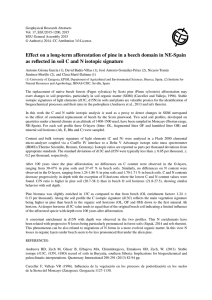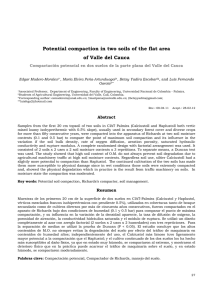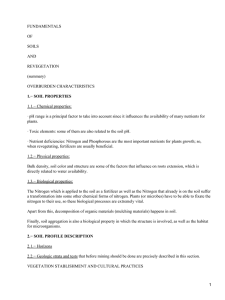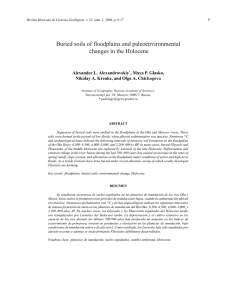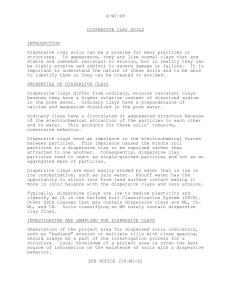a preliminary comparative investigation of phosphorus in irish
Anuncio
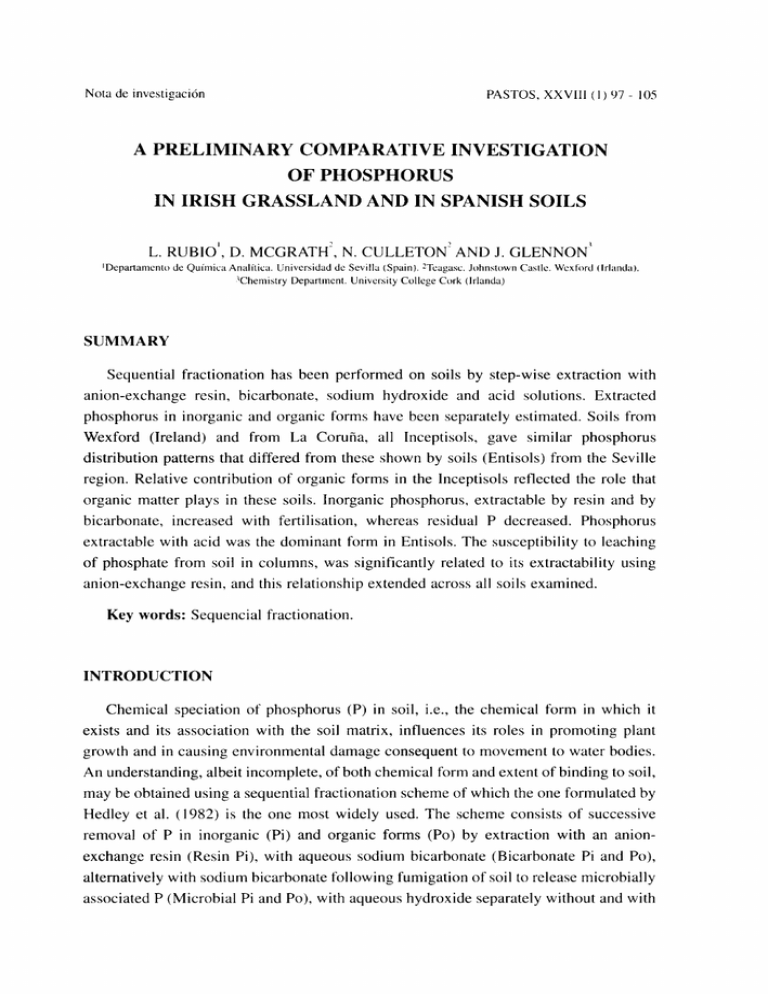
Nota de investigación PASTOS, XXVIII ( 1 ) 9 7 - 105 A PRELIMINARY COMPARATIVE INVESTIGATION OF PHOSPHORUS IN IRISH GRASSLAND AND IN SPANISH SOILS L. RUBIO', D. MCGRATH', N. CULLETON' AND J. GLENNON' 'Departamento de Química Analítica. Universidad de Sevilla (Spain). 2Teagasc. Johnstown Castle. Wcxl'ord (Irlanda). ^Chemistry Department. University Collcge Cork (Irlanda) SUMMARY Sequential fractionation has been performed on soils by step-wise extraction with anion-exchange resin, bicarbonate, sodium hydroxide and acid solutions. Extracted phosphorus in inorganic and organic forms have been separately estimated. Soils from Wexford (Ireland) and from La Coruña, all Inceptisols, gave similar phosphorus distribution patterns that differed from these shown by soils (Entisols) from the Seville región. Relative contribution of organic forms in the Inceptisols reflected the role that organic matter plays in these soils. Inorganic phosphorus, extractable by resin and by bicarbonate, increased with fertilisation, whereas residual P decreased. Phosphorus extractable with acid was the dominant form in Entisols. The susceptibility to leaching of phosphate from soil in columns, was significantly related to its extractability using anion-exchange resin, and this relationship extended across all soils examined. Key words: Sequencial fractionation. INTRODUCTION Chemical speciation of phosphorus (P) in soil, i.e., the chemical form in which it exists and its association with the soil matrix, influences its roles in promoting plant growth and in causing environmental damage consequent to movement to water bodies. An understanding, albeit incomplete, of both chemical form and extent of binding to soil, may be obtained using a sequential fractionation scheme of which the one formulated by Hedley et al. (1982) is the one most widely used. The scheme consists of successive removal of P in inorganic (Pi) and organic forms (Po) by extraction with an anionexchange resin (Resin Pi), with aqueous sodium bicarbonate (Bicarbonate Pi and Po), alternatively with sodium bicarbonate following fumigation of soil to reléase microbially associated P (Microbial Pi and Po), with aqueous hydroxide separately without and with 98 PASTOS 1998: Nota de investigación sonication (Sonic NaOH Pi and Sonic NaOH Po) and with hydrochloric acid (HC1 Pi). Phosphorus in residual soil (Residual P) and total P are also determined. The extent to which information on soil P fractions reflects soil development and weathering on one hand and anthropogenic activity, and especially P fertiliser application, on the other is considered here. Together with existing information on Irish (Power, 1992) and Spanish (Trasar-Cepeda et al, 1990) soils this will assist in understanding of the processes heading to mobilisation of P active in plant-uptake and in movement to water systems. EXPERIMENTAL Soils Soils were sampled (0-10 cm) in 1995. Three were from Wexford, three from Seville and three from La Coruña. Both Wexford and Seville samples were from adjacent sites of each which had been uniformly fertilised since 1966 and 1990 respectively. Soil classification, land-use and recent fertiliser history is shown in Table 1. Soils were partially air-dried at T<20°C until sufficiently workable to pass a 2 mm mesh. Sequential fractionation scheme The procedure used was that of Hedley et al. (1982) in which soil (500 mg) was sequentially extracted using Dowex 1 X 8 in muslin sachets, 0.1 M sodium bicarbonate (after fumigation and without fumigation, soil subjected to the latter treatment then being discarded), 0.1 M aqueous sodium hydroxide, 0.1 M sodium hydroxide while undergoing ultrasonication, and with 1 M hydrochloric acid. The procedure defined by Hedley et al (1982) was closely adhered to: extracts were separated from soil following centrifugation at 12,000 rpm and were clarified by passage through Whatman No. 2 filter paper. They were suitably diluted and adjusted to pH 6 for estimation as pyrophosphate using the Murphy-Riley procedure (1962), as described by Byrne (1979). This allows for the estimation of Pi. An aliquot of extract was also subjected to oxidation with acidified potassium persulphate (EPA, 1971) to convert all P in solution to inorganic P. Po was then determined by difference. Total P in soil and residual P in soil after HC1 extraction was also determined following fusión with NaOH (Smith and Bain, 1982). All analyses were performed in quadruplicate and the mean taken. PASTOS 1998: Nota de investigación 99 Other analysis Soil pH in water, P, potassium (K) and magnesium (Mg) were determined following extraction of soil with Morgan's reagent (Byrne, 1979). Soil moisture contení was determined by heating at 105 °C to constant weight and loss on ignition by heating at 450° overnight. Column leaching trial A glass column (50 mm diameter) was used to hold soil (500 g), gently-packed to a depth of ca 250 mm. Black plástic foil was used to exelude light. Water was gently applied from above at a flow rate of 0.2 mi min 1 . Eluate was collected in 100 mi fractions to 500 mi and thereafter in 500 mi fractions to 3000 mi. Inorganic P in solution was monitored and concentration was plotted against eluate volume. The concentration stabilised after ca 1,000 mi and remained approximately constant thereafter. This equilibrium concentration was assessed. RESULTS AND DISCUSSION Soils Wexford soils (Table 1) were from under grass and so are representative of soil utilised for the dominant agricultural activity in the country. For comparative purposes, soils with similar pedogenesis from La Coruña, in Galicia, Inceptisols (brown earths) with characteristically elevated soil organic matter, were selected. Soil from the Seville región, Entisols or characteristically young soils, poorly developed and having a low level of organic matter and with much of the phosphorus component incorporated in the primary mineral bydroxyapatite, were chosen as being dissimilar. Two soils from the La Coruña área were until recently under grass whereas all the Seville soils were under tillage. Each set of soils represented a series with at least one member having relatively low plant-available P and one member having much more, when soils were subjected to the Morgans extraction test for P (Table 2). PASTOS 1998: Nota de investigación 100 TABLE 1 Description of soils used Descripción de los suelos usados Designation Classification Location FAO-UNESCO USDA Previous use Fertiliser history Wl Wextord Inceptisol Pasture Since 1966; No P W2 Wextord Pasture Since 1966; Pat 15 kg ha1 a1 W3 Wextord Pasture Since 1966; Pat 30 kg ha' a1 SI Seville Maize(1993), Since 1993; No P Stagno Gleyie Cambisol Gleio Eutric Fluvisol Entisol beetroot(1994). sunflower(1995) Since 1993; Pat 26 kg ha1 a1 S2 Seville Maize (1993-1995) S3 Seville Maize (1993-1995) Since 1993; Pat 80 kg ha1 a' Gl La Coruña Humic Cambisol Forest Since 1993. No P G2 La Coruña Pasture since 1990 Since 1993/1994; 75/60 kgP G3 La Coruña Pasture, maize's (1994) Unknown large amounts of Inceptisol animal slurry TABLE 2 Soil properties Propiedades del suelo Soil Moisture Loss on ignition (g kg-1) (gkg-D Wl 270.6 85.4 W2 276.9 W3 pH Extractable (mg 1-1 soil) P K Mg 5.2 1 238 210 89.0 5.4 6 149 215 287.4 106.8 6.1 20 168 420 SI 85.4 13.0 8.8 30 110 490 S2 55.8 13.8 8.8 42 95 580 S3 54.9 12.6 8.6 65 114 520 Gl 51.6 184.1 5.1 2 81 66 G2 80.5 141.1 5.4 5 640 190 G3 35.1 95.5 5.5 7 220 113 PASTOS 1998: Nota de investigación 101 P fractionation Soils were fractionated according to the procedure described by Hedley et al. (1982). Recoveries of phosphorus were considered to be good, 94.4, 89.9 and 102.0% for the Wexford soils, 106.7, 104.7 and 90.9% for Seville soils and 95.4, 95.8 and 85.9% for La Coruña soils. In order to better comprehend patterns in sequential extraction schemes, fractions are generally expressed as a proportion of total recovery for P (Cross and Schlesinger, 1995) and, indeed, for other soil components such as trace elements (Tessier et al, 1979). In the present examination, microbial P was measured separately (Table 3) but was included with NaOH fractions (Figure 1) where it would almost certainly appear were it not previously measured: Cross and Schlesinger (1995) in their review made no accommodation for this fraction. It was clear that Wexford soils contained much more P in this microbia fraction than did Spanish soils. This effect may have been related to circumstances attaining prior to examination, e.g., temperature or moisture content in the field, and amount of easily degradable organic matter, factors which could be expected to influence microbial biomass and activity. TABLE 3 Phosphorus removed in sequential extraction (mg kg 1 dry soil) Fósforo retirado en extracción secuencia! (mg kg' de suelo seco) Inorganic (Pi) Soil Organic (Po) Resin Bicarbonate Microbial NaOH Sonic- HCI Residual Bicarbonate Microbial NaOH Sonic- Total P NaOH NaOH Wl 10.2 14.8 55.0 26.6 3.5 15.6 187.6 33.4 8.1 162.3 20.8 570.1 W2 32.3 62.5 85.5 81.6 7.7 38.8 180.2 30.1 30.1 245.4 29.0 915.3 W3 62.4 162.7 76.9 187.1 16.2 147.7 279.0 8.2 60.9 219.5 42.4 1238.3 SI 21.8 13.6 10.2 5.7 0.9 190.2 153.7 2.5 6.1 15.3 0.2 394.0 S2 23.1 14.4 9.2 8.0 0.9 230.6 133.4 3.3 1.4 6.5 0.0 411.4 S3 39.8 23.8 13.0 6.0 0.8 176.1 118.5 2.4 3.2 7.8 0.6 426.6 Gl 5.1 6.5 0.0 48.0 5.4 17.7 190.3 39.7 0.0 98.6 17.1 449.3 G2 33.6 79.2 16.7 322.1 17.9 50.6 280.7 32.8 20.9 163.0 29.5 1092.0 m 36.2 80.5 25.7 257.5 18.1 84.6 275.6 44.5 7.3 220.3 26.5 1253.3 PASTOS 1998: Nota de investigación 102 INORGANIC P FIGURE 1 Phosphorus fractions - % of total P (see Table 1 for designations) Fraccionamiento del fósforo - % del P total (ver Tabla 1 para designaciones) In their summary of P fractionation results, which were restricted to natural, unfertilised or uncultivated soils, mostly from the Americas but also from Spain, Cross and Schlesinger (1995) drew a number of conclusions relating to the formation or pedogenesis of soils, covering 9 of the 10 soil orders. Although soils here differ slightly from those reviewed by Cross and Schlesinger (1995) being sampled to 10 cm rather than to 15 cm, their conclusions can serve as reference. Comparison are made for unfertilised soils Wl, SI and Gl, unless otherwise stated (Table 3 and Figure 1). 1) As found by Cross and Schlesinger (1995), resin- and bicarbonate- extracted Pi generally made up less than 4 and 6%, respectively, of total P. However, the proportion increased with fertiliser application. 2) Pi in NaOH and sonic NaOH extracts made up less than 25 and 5%, respectively of total P. This was true for all Inceptisols (except G2). For Seville soils both fractions were characteristically only 1-2% of total P. 3) Po total, comprising the fractions that were considered by Cross and Schlesinger to be biologically-active, was 5% of total P for Seville soils and about 35% of PASTOS 1998: Nota de investigación 103 total P for Wexford and La Coruña soils. This was not too surprising as the latter soils had exceptionally high organic matter levéis for mineral soils. Such a high Po was a further manifestation of the dominant influence of organic matter in Irish grassland soils (McGrath, 1997). 4) HCl-extractable P (considered to be almost entirely Pi) was most predominant in alkaline soil, e.g. in Seville soils. 5) Residual P in unfertilised soil had a valué approaching or exceeding 40%. However, on fertilisation it decreased. The effect of fertiliser The most obvious effect of fertiliser application over time was to increase total P content of soils, an effect that was most clearly shown by the Wexford soils. As stated above, fertilisation also increased the proportion of resin-, bicarbonate- and NaOHextractable Pi while decreasing the proportion of NaOH Po and residual P. It also of course increased the valué of P in the soil test (Table 2). The depression in Po (Figure 1) is not explicable on the basis of lower soil organic matter - as it has been in prairie soils following cultivation (Tiessen et al., 1983). Leaching trial P leached in the column procedure increased with increasing fertilisation. Extent of leaching was greater for Seville than for other soils. Within each soil group leached P increased with other soil parameters, including test P and Hedley et ai, resin and bicarbonate P. The clearest relationship across soil types between P fraction (Table 3) and other data was with proportion of resin absorbed P - not the absolute valué - as shown in Figure 2. It may well be that this parameter could serve as a useful index leachability for P - especially across soils with widely different total-P content, génesis and composition. PASTOS 1998: Nota de investigación 104 1.6 1.4 O) 1.2 S3 y = 0.0197x 2 - 0.03 16X + 0.0343 R2 = 0.96 E 1.0 0.8 JO o ni o W3 0.6 • 0.4 0.2 0 G3 G1 W2 S1 W1 -i 10 Resin P (%) FIGURE 2 Concentration of P in leachate v resin-P, expressed as a % of total soil P Concentración de P en el lixiviado vs P-resina, expresado en % del P total en el suelo BYRNE, E., 1979. Chemical Analysis of Agricultural Materials. An Foras Taluntais. 194 pp. Wexford (Ireland). CROSS, A.F.; SCHLESINGER, W.H., 1995. A literature review and evaluation of the Hedley fractionation: Applications to the biogeochemical cycle of soil phosphorus in natural ecosystems. Geoderma, 64, 197214. E.P.A.,1971. Methods of Chemical Analysis of Water and Wastes. The Environmental Protection Agency. Cincinnati, Ohio (USA). HEDLEY, M.J., STEWART, J.W.B. AND CHAUHAN, B.S., 1982. Changes in inorganic and organic soil phosphorus fractions induced by cultivation practices and by laboratory incubation. Soil Sci. Soc. Amer. Proc, 46, 970-976. MCGRATH, D., 1997. Extractability, chemical composition and reactivities of soil organic matter of Irish grassland soils. Symposium on Humic Substances in Soils, Peats and Waters. British and Irish Chapter of the International Humic Systems, 31-38. Dublin. 18-19 September, 1995 MURPHY, J. AND RÍLEY, J.P., 1962. A modified single solution method for the determination of phosphorus in natural waters. Anal. Chem. Acta, 27, 31-36. POWER, V., 1992. Phosphorus maintenance requirement for silage production and availahilitx of soil phosphorus reserves. Ph.D. Thesis, 158pp. University of Dublin (Irlanda). PASTOS 1998: Nota de investigación 105 SM1TH. B.F.L.; BAIN, 1982. A sodium hydroxide fusión method for the determination of total phosphate in soil. Commun. in Soil Sci. und Plant Anal., 13, 185-190. TESSIER. A. CAMPBELL, P.G.C.; BISSON. M., 1979. Sequential fractionation procedure for the speciation of particulate trace metáis. Anal. Chem., 51, 844-851. TIESSEN, H., STEWART, J.W.B.; MOIR. J.O., 1983. Changes in organic phosphorus composition of two grassland soils and their particle size fractions during 60-90 years of cultivation. J. Soil Sci., 34, 815-823. TRASAR-CEPEDA. M.A., GIL-SOTRES, F. AND QUITIAN-OJEA, E, 1990. Rclation between phosphorus fractions and development of soils from Galicia (N.W. Spain). Geoderma, 27, 139-150. INVESTIGACIÓN PRELIMINAR COMPARATIVA DEL FÓSFORO EN SUELOS IRLANDESES Y ESPAÑOLES RESUMEN En este trabajo se describe un método de extracción secuencial, aplicado a la determinación de fósforo en suelos. Dicho método consiste en la extracción de fósforo, paso a paso, mediante el uso sucesivo de resinas de intercambio iónico, bicarbonato sódico, hidróxido sódico y ácidos. El fósforo extraído ha sido cuantificado por separado, en sus formas orgánicas e inorgánicas. Los suelos de Wexford (Irlanda) y La Coruña, clasificados todos ellos como Inceptisoles, mostraron patrones de distribución de fósforo similares entre sí. Dicha distribución difiere, sin embargo, de la mostrada por los suelos sevillanos, clasificados como entisoles. El alto contenido relativo de formas orgánicas de fósforo en los inceptisoles estudiados, es indicativo del importante papel que la materia orgánica juega en dichos suelos. En todos los suelos estudiados, la proporción del fósforo inorgánico, extractable mediante el uso de resinas y disoluciones de bicarbonato, aumenta con la cantidad de fertilizante añadida al suelo, mientras que la porción de fósforo residual disminuye. La susceptibilidad a la lixiviación del fósforo en suelos, estudiada mediante el uso de columnas de lixiviación experimentales, muestra una estrecha relación con la fácil extracción por medio de resinas de intercambio de aniones. Dicha relación se extiende a la totalidad de los suelos estudiados. Palabras clave: Extracción secuencial.


